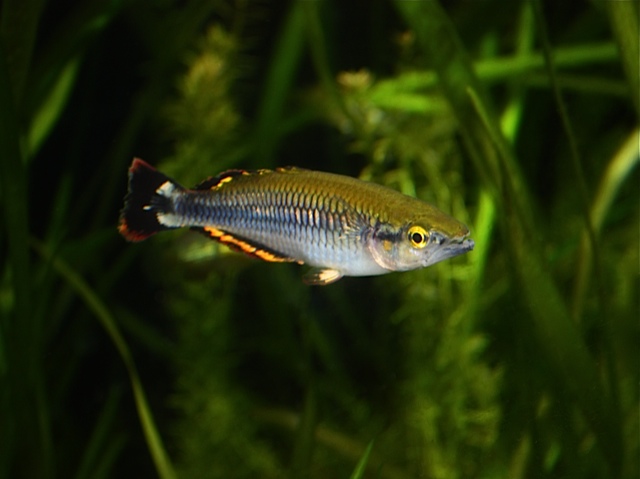TAXONOMY
Phylum: Chordata
Class: Actinoptgerygii
Order: Periciformes
Family: Chichlidae (Cichlids)
Genus/species: Paratilapia polleni
GENERAL CHARACTERISTICS: Mid-sized cichlid, growing to 30 cm (12 in) in length; males grow up to a third again as large as females; black velvet basic coloration with pattern of blue and gold spangling. Distinct spot present in dorsal fin of juveniles and sexually quiescent adults.
Adult male fish are much larger than females and develop longer extensions on the dorsal and anal fins. They also tend to have a more rounded head shape.

DISTRIBUTION/HABITAT: Endemic to Madagascar found in freshwater at altitudes up to 1,500 m (5000 ft) and exhibit tolerance for a broad temperature range.
DIET IN THE WILD: Carnivorous, juveniles feed chiefly on planktonic crustaceans and insect larvae; larger fish are crepuscular predators with a preference for small fishes, but also take invertebrates as opportunity presents.

REPRODUCTION: Marakely parenting is a two-fish job. They are monogamous, biparentally custodial substrate spawners. Pairs defend a territory and both sexes assume a velvety black base coloration as spawning approaches. They excavate a gravel pit and spawn in it excluding other fish from area. Each egg has a long adhesive fiber that adheres to other egg fibers, forming a rope of eggs (up to a thousand) rolled into an egg mass. The male patrols the perimeter of the territory as the fry become mobile four days post-hatching. Both parents follow the school of fry, retrieving stragglers by mouth and spitting them back into the school. Parental care continues for about three weeks. These protective behaviors promote reproductive success common to many cichlid species.
PREDATORS: In the southern part of its range, the exotic spotted snakehead is both a competitor and predator. Paratilapia polleni have lived for up to 15 years in aquariums.
CONSERVATION: IUCN Red List; Vulnerable (VU) Qualifies as Vulnerable on account of its limited distribution and fragmented habitat (mainly due to deforestation of river catchments) which are causing a continued decline in available habitat and the number of mature individuals in the population.
A Marakely captive breeding program is supported by many aquariums and zoos.
REMARKS. The most primitive living representatives of the large Cichlidae family. Some of Madagascar’s freshwater fish species have ancestors dating back to the Jurassic period.
Madagascar MA04
References
fishbase www.fishbase.org/summary/Paratilapia-polleni.html
IUCN www.iucnredlist.org/details/16199/0
California Academy of Sciences Rainforest Docent Training Manual 2014
Ron’s flickr https://www.flickr.com/photos/cas_docents/3637198814/in/set-72157620708610230/
WordPress Shortlink wp.me/p1DZ4b-yh

















